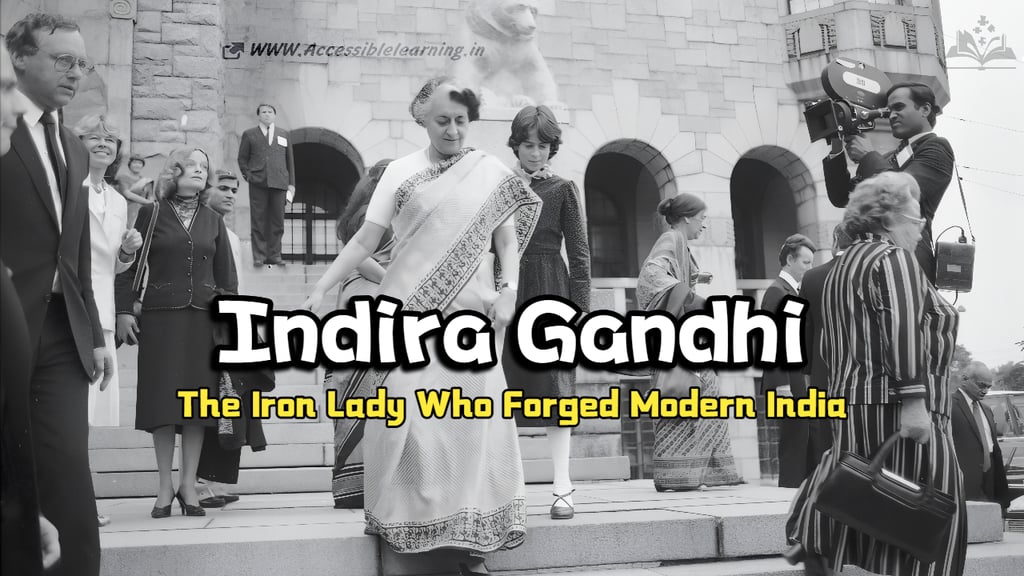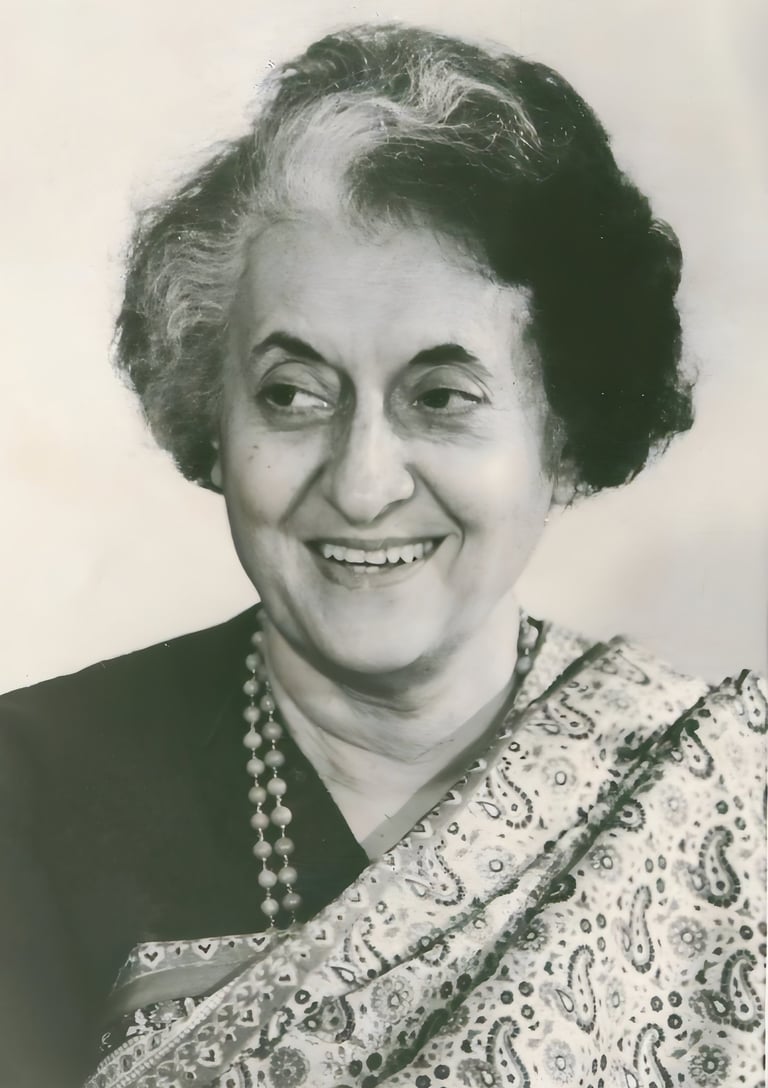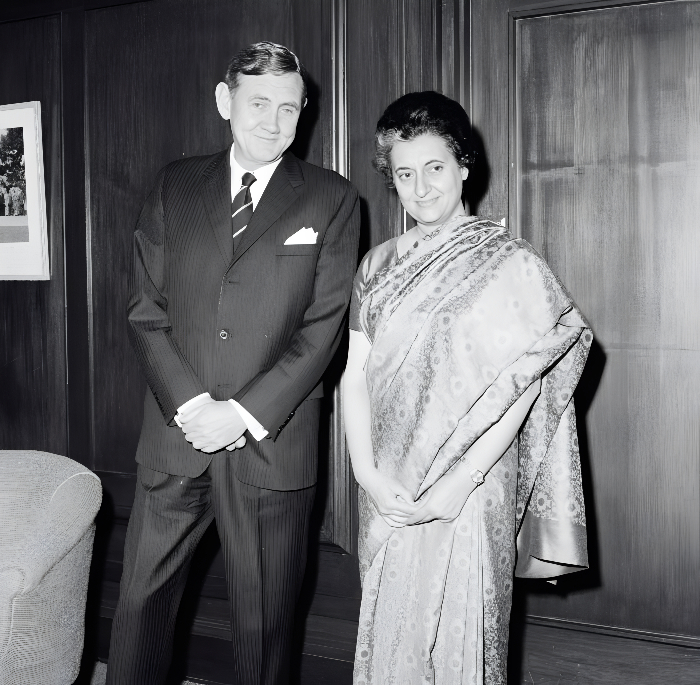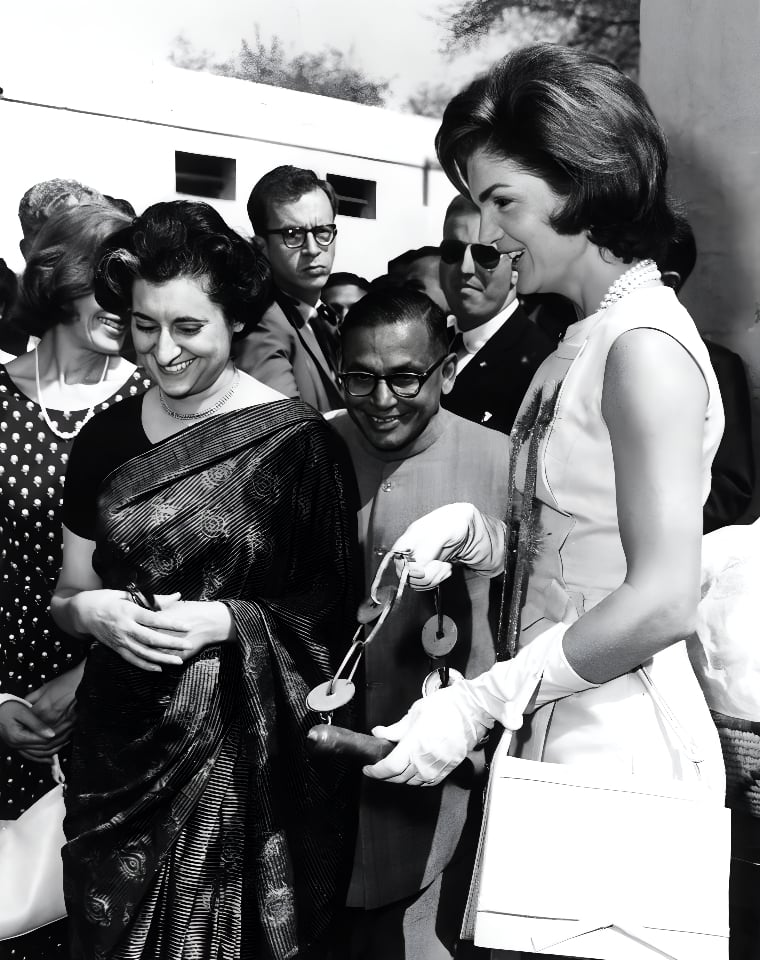
Indira Gandhi: The Iron Lady Who Forged Modern India
Explore the extraordinary life and legacy of Indira Gandhi, India's first female Prime Minister, whose bold policies and complex leadership transformed a nation. This comprehensive guide examines her journey from freedom fighter's daughter to powerful world leader, revealing the triumphs, controversies, and enduring impact that continue to shape modern India.
BIOGRAPHY/HISTORYEDUCATION/KNOWLEDGEINDIAN HISTORY
Sachin K Chaurasiya
3/27/202513 min read


Indira Gandhi stands as one of the most influential figures in modern Indian history. As India's first and only female Prime Minister to date, she shaped the nation's political landscape during crucial decades of development and challenge. Her leadership style, marked by both remarkable achievements and controversial decisions, continues to spark debate among historians and political analysts. This article explores the life, political career, and lasting impact of a woman whose legacy remains deeply intertwined with India's national identity.
Early Life and Political Beginnings
Born on November 19, 1917, in Allahabad, Indira Priyadarshini was the only child of Jawaharlal Nehru, who would become India's first Prime Minister after independence. Her early life was shaped by the Indian independence movement, with her family deeply involved in the struggle against British colonial rule. While other children enjoyed typical childhoods, young Indira witnessed political meetings, participated in demonstrations, and watched her parents face multiple imprisonments for their political activities.
Her mother, Kamala Nehru, was a freedom fighter in her own right who influenced Indira's early political consciousness. When Indira was only 12 years old, she formed the "Monkey Brigade," a children's group that helped deliver messages and materials to freedom fighters evading British authorities—an early demonstration of her organizational skills and commitment to the independence cause.
Indira's education took her from India to Europe, studying at institutions including Somerville College and Oxford University, though she never completed a degree. Her studies were interrupted by frequent illnesses and her return to India to care for her ailing mother. These formative years exposed her to diverse political ideologies and international perspectives that would later influence her governance approach.
Her marriage to Feroze Gandhi (no relation to Mahatma Gandhi) in 1942 against her father's initial objections showed her independent spirit. The couple had two sons, Rajiv and Sanjay, before their marriage became strained due to political differences and long separations.
Her entry into politics came naturally, initially serving as her father's hostess and confidante after her mother's death in 1936. This apprenticeship provided invaluable insights into governance and diplomacy. In 1959, she was elected President of the Indian National Congress, marking her formal entry into party politics.
Rise to Power
Following her father's death in 1964, Indira Gandhi served briefly as Minister of Information and Broadcasting under Prime Minister Lal Bahadur Shastri. When Shastri died unexpectedly in 1966, Congress party leaders selected Gandhi as Prime Minister, possibly underestimating her political acumen and viewing her as a malleable figurehead.
They soon discovered their miscalculation. Initially dismissed as a "dumb doll" (goongi gudiya) by political opponents, Gandhi quickly demonstrated her political shrewdness and determination. She built her own power base within the party, connecting directly with India's masses through effective communication and populist policies.
The Congress Party split in 1969, with Gandhi leading the more progressive faction (Congress-R) against the old guard known as the Syndicate. This split, triggered by differences over economic policies and control of the party machinery, established Gandhi as a leader in her own right rather than merely her father's daughter.
The 1971 election campaign, with its powerful slogan "Garibi Hatao" (Remove Poverty), showcased her ability to translate complex political issues into messages that resonated with ordinary citizens. Her landslide victory established her as a formidable political force independent of her family name.


Key Achievements and Policies
Economic Reforms and Nationalization
Gandhi implemented sweeping economic reforms that reshaped India's business landscape. Her administration nationalized 14 major banks in 1969, bringing banking services to previously underserved rural areas and directing credit toward priority sectors. This move, while controversial among business elites, demonstrated her willingness to challenge established economic interests in pursuit of broader development goals.
The nationalization extended to other industries, including insurance, coal, and oil. The Coal Mines (Nationalization) Act of 1973 brought the entire coal industry under government control, while the General Insurance Business (Nationalization) Act of 1972 established the state's monopoly over insurance. These policies reflected Gandhi's vision of a self-reliant India with a strong public sector guiding economic development.
Gandhi also introduced the Monopolies and Restrictive Trade Practices Act (MRTP) in 1969, which aimed to prevent the concentration of economic power and control monopolistic practices. This legislation, alongside the Foreign Exchange Regulation Act (FERA) of 1973, sought to regulate foreign investment and promote Indian ownership of businesses.
Green Revolution
Under Gandhi's leadership, India embraced agricultural modernization through the Green Revolution. This comprehensive program introduced high-yielding seed varieties, modern farming techniques, and improved irrigation systems. The results were transformative—India transitioned from food dependency to self-sufficiency, averting the famines that had plagued the nation for generations.
Gandhi's government established the Agricultural Prices Commission and the Food Corporation of India to ensure fair prices for farmers and effective food distribution. The creation of a national agricultural research network, including regional agricultural universities and extension services, provided critical support for implementing new technologies.
This achievement had profound implications beyond agriculture, boosting rural incomes, reducing poverty, and establishing food security as a cornerstone of India's development strategy. The Green Revolution also transformed India's agricultural landscape, particularly in Punjab and Haryana, which became the country's breadbasket regions.
Foreign Policy and National Security
Gandhi's foreign policy represented a blend of pragmatism and principle. While maintaining India's non-aligned stance, she skillfully navigated Cold War politics, signing the Indo-Soviet Treaty of Friendship and Cooperation in 1971 while simultaneously maintaining relations with Western powers.
Her finest hour in international affairs came during the 1971 Bangladesh Liberation War. When millions of refugees fled to India from East Pakistan (now Bangladesh) due to military crackdowns, Gandhi provided diplomatic, humanitarian, and eventually military support. She toured world capitals to raise awareness about the crisis and withstood significant international pressure, particularly from the United States, which had deployed the USS Enterprise to the Bay of Bengal in a show of support for Pakistan. India's decisive victory in the subsequent 13-day war led to Bangladesh's independence and established India as the dominant regional power in South Asia.
In 1974, India conducted its first nuclear test under Gandhi's authorization, joining the exclusive club of nuclear powers and signaling India's technological advancement and strategic autonomy. Code-named "Smiling Buddha," the test was described as a "peaceful nuclear explosion" but nevertheless established India's nuclear capabilities.
Gandhi also strengthened India's position in the Non-Aligned Movement, hosting the 1983 NAM summit in New Delhi. Her international stature grew as she advocated for developing nations' interests in global forums, particularly regarding trade, technology transfer, and decolonization issues.
Social Reforms and Anti-Poverty Programs
Gandhi's government implemented several ambitious social welfare programs aimed at reducing poverty and inequality. The Integrated Rural Development Program (IRDP) provided subsidized loans to rural poor for productive assets, while the Twenty-Point Program encompassed various initiatives targeting poverty alleviation, land reform, and social justice.
In 1975, Gandhi introduced the Minimum Needs Program, which focused on providing essential services like education, health, water supply, and road connectivity to rural areas. The Fifth Five-Year Plan (1974-1979) under her leadership emphasized self-reliance and poverty reduction through expanded public sector investments.
The ambitious "Garibi Hatao" (Remove Poverty) campaign included measures like the Small Farmers Development Agency, Drought Prone Areas Program, and Tribal Development Agency, all designed to address the specific needs of vulnerable populations.


Controversies and Criticisms
The Emergency Period (1975-1977)
The most controversial chapter in Gandhi's career began in June 1975, when, facing a conviction for election fraud and widespread protests, she declared a national emergency. This 21-month period saw the suspension of civil liberties, imprisonment of political opponents, press censorship, and forced sterilization programs as part of population control efforts.
During this period, Gandhi's younger son Sanjay emerged as a powerful and controversial figure, implementing urban slum clearance programs and aggressive family planning initiatives. The sterilization campaign, which reportedly resulted in over 8 million procedures (many allegedly coerced), remains one of the most criticized aspects of the emergency.
Constitutional amendments enacted during this period, particularly the 42nd Amendment, significantly expanded the government's powers at the expense of judicial review and individual rights. These changes sought to insulate Gandhi's policies from judicial scrutiny and cement her control over state machinery.
Defenders argue these measures were necessary to restore order and implement economic reforms, pointing to improved discipline, reduced inflation, and administrative efficiency during this period. Critics maintain the emergency represented a fundamental assault on India's democratic institutions and revealed Gandhi's authoritarian tendencies.
The Indian electorate delivered its verdict in the 1977 elections, ousting Gandhi and the Congress party from power for the first time since independence. The Janata Party coalition, led by Morarji Desai, formed the government, though internal contradictions would lead to its collapse by 1979, paving the way for Gandhi's return to power.
Operation Blue Star and Sikh Tensions
The roots of the Punjab crisis lay in complex religious, political, and economic factors. The Akali Dal, a Sikh political party, had been demanding greater autonomy for Punjab through the Anandpur Sahib Resolution. Simultaneously, extremist elements led by Jarnail Singh Bhindranwale had taken up arms in pursuit of a separate Sikh homeland called Khalistan.
By early 1984, Bhindranwale and his armed followers had established a fortified base within the Golden Temple complex in Amritsar, Sikhism's holiest shrine. After failed negotiations and escalating violence, Gandhi ordered the Indian Army to storm the temple in an operation code-named "Blue Star" in June 1984.
The operation succeeded militarily but caused significant damage to the temple complex and resulted in hundreds of casualties, including civilians. The assault on the Akal Takht, one of the most revered structures within the complex, caused particular outrage among Sikhs worldwide.
This decision deeply alienated many in the Sikh community and ultimately led to Gandhi's assassination by her Sikh bodyguards, Beant Singh and Satwant Singh, on October 31, 1984. The subsequent anti-Sikh riots, which claimed thousands of lives, further damaged her legacy and left lasting scars on India's social fabric. Critics argue that Gandhi's government failed to adequately protect Sikh citizens during these riots, with some alleging that certain Congress leaders actively encouraged the violence.
Corruption Allegations and Dynastic Politics
Gandhi's administration faced mounting corruption allegations, particularly during her later years in office. The Nagarwala case, involving the fraudulent withdrawal of funds from the State Bank of India, and the Kuo oil deal controversy raised questions about financial impropriety within her government.
Critics also pointed to the rise of her younger son Sanjay Gandhi during the Emergency period as evidence of nepotism and dynastic politics. Following Sanjay's death in a plane crash in 1980, Gandhi groomed her elder son Rajiv, initially reluctant to enter politics, as her successor. This establishment of the Nehru-Gandhi dynasty in Indian politics remains a controversial aspect of her legacy.
Leadership Style and Personal Characteristics
Gandhi's leadership style combined charisma, decisiveness, and pragmatism. She possessed remarkable political instincts and the ability to connect with India's diverse population despite her privileged background. Her speeches often emphasized nationalism, self-reliance, and social justice, themes that resonated across regional and linguistic divides.
Known for her impeccable timing in political maneuvers, Gandhi displayed an uncanny ability to anticipate and respond to emerging challenges. Her decision to support the Bengali liberation movement in 1971, for instance, combined humanitarian concerns with strategic calculations about India's regional position.
Those who worked closely with Gandhi described her as detail-oriented, demanding, and sometimes imperious. She maintained a small circle of trusted advisors and increasingly centralized decision-making, particularly during her later years in office. This concentration of power, while enabling decisive action, also limited institutional development and democratic processes.
Despite her public persona as India's "Iron Lady," Gandhi maintained a complex private life. Widowed at a young age when her husband Feroze Gandhi died in 1960, she devoted herself to politics while raising her two sons, Rajiv and Sanjay. Her relationship with Sanjay, who became a controversial political figure during the Emergency, revealed both her political pragmatism and maternal loyalty.
Gandhi's personal interests included wildlife conservation, poetry, and photography. She played a significant role in establishing wildlife sanctuaries across India and implementing the Wildlife Protection Act of 1972. Her letters to her father during his imprisonment, later published as "Two Alone, Two Together," reveal a contemplative and intellectual side often overshadowed by her political persona.


Cultural Influence and Public Image
Gandhi cultivated a distinctive public image that combined traditional Indian values with modern leadership qualities. Her choice of attire—simple handloom saris with a characteristic white streak in her hair—became iconic and reflected her connection to India's cultural heritage while projecting an image of austere dedication.
Her oratorical skills, particularly in Hindi, allowed her to communicate effectively with masses across northern India. Gandhi's speeches often invoked nationalist themes and emphasized her direct connection with the people, bypassing party structures and institutional intermediaries.
The Indian media's relationship with Gandhi evolved dramatically over her career. Initially portrayed positively as Nehru's daughter and a symbol of women's empowerment, media coverage became increasingly critical during the Emergency when press censorship was imposed. The state-controlled media, particularly All India Radio and Doordarshan, were used effectively to promote government policies and Gandhi's leadership narrative.
Various films, books, and cultural productions have attempted to capture Gandhi's complex legacy. The most notable cinematic portrayal came in Richard Attenborough's "Gandhi" (1982), where Rohini Hattangadi played her role. Biographical works like Katherine Frank's "Indira: The Life of Indira Nehru Gandhi" and Pupul Jayakar's "Indira Gandhi: A Biography" offer contrasting perspectives on her life and career.
Economic Legacy
Gandhi's economic policies, sometimes referred to as "Indira socialism," represented a distinctive approach to development that combined state control of key industries with selective market incentives. The expansion of the public sector under her leadership created employment opportunities and industrial capacity but also led to inefficiencies and bureaucratic control that later reforms sought to address.
The nationalization of banks significantly expanded financial inclusion, with rural bank branches growing from 1,833 in 1969 to over 25,000 by 1980. Priority sector lending requirements ensured credit flow to agriculture, small businesses, and weaker sections of society, advancing Gandhi's social justice objectives.
However, the economic model also created challenges. Industrial licensing requirements, import restrictions, and foreign exchange controls (collectively known as the "License Raj") created opportunities for corruption and rent-seeking behavior that constrained economic dynamism and entrepreneurship.
The fiscal implications of Gandhi's welfare programs and public sector investments led to growing budget deficits, which would eventually contribute to the balance of payments crisis that prompted economic liberalization in 1991. Yet many of the institutions she established, from the national banks to research organizations, continue to play important roles in India's development.
Political Legacy and Institutional Impact
Gandhi's governance approach fundamentally altered India's political landscape. The centralization of power within the Prime Minister's office and the erosion of state autonomy through the frequent use of President's Rule (dismissal of state governments) established precedents that successive governments have followed to varying degrees.
Her strategy of appealing directly to voters based on charismatic leadership and populist promises, bypassing party structures and local leaders, transformed campaign politics in India. The personalization of political messaging, with slogans like "India is Indira and Indira is India," created a template for personality-based politics that remains influential.
Gandhi's approach to federalism—intervening in state politics when politically expedient while simultaneously expanding central government authority—established patterns of center-state relations that continue to evolve. Her willingness to redraw state boundaries along linguistic lines, as with the creation of Haryana, Himachal Pradesh, and Meghalaya, acknowledged the importance of cultural and linguistic identity in Indian politics.
The Emergency period's excesses led to important institutional reforms designed to prevent similar abuses. The 44th Constitutional Amendment, passed after Gandhi's electoral defeat, restored many democratic safeguards by limiting the government's emergency powers and strengthening judicial independence.
Enduring Legacy
More than three decades after her death, Indira Gandhi's legacy continues to evoke strong reactions. She remains a polarizing figure—admired for her strength, vision, and achievements in nation-building, yet criticized for undermining democratic institutions during the Emergency and for decisions that exacerbated communal tensions.
Her economic policies, particularly nationalization and emphasis on self-reliance, shaped India's development model for decades. While many of these policies have been modified or reversed in the post-liberalization era, their impact on India's industrial base and social sectors endures.
The environmental initiatives launched during her tenure, including the Water Prevention and Control of Pollution Act (1974) and the Forest Conservation Act (1980), established India's modern environmental regulatory framework. Her personal interest in wildlife conservation led to the creation of numerous national parks and sanctuaries, including the Project Tiger initiative launched in 1973.
Gandhi's influence extends beyond policy to political culture. She pioneered the personalization of Indian politics, bypassing party structures to appeal directly to voters. This approach, combining charismatic leadership with populist messaging, has been emulated by subsequent Indian politicians across the political spectrum.
Perhaps most significantly, Gandhi expanded the boundaries of what was possible for women in Indian politics. While her rise was undoubtedly facilitated by her family connections, her ability to dominate a male-dominated political landscape demonstrated that women could exercise power effectively in the highest office.
The Nehru-Gandhi political dynasty that she consolidated continues to influence Indian politics through the Indian National Congress party, though its electoral fortunes have varied considerably. The legacy of dynastic politics that she established extends beyond her own family to various regional political dynasties across India.


International Recognition
Gandhi's international stature was recognized through numerous awards and honors. She received the Bharat Ratna, India's highest civilian award, in 1971. International recognitions included the Lenin Peace Prize (1971) and honorary doctorates from universities worldwide.
Her influence on global affairs was particularly notable in the developing world. As a leading voice in the Non-Aligned Movement, she advocated for a more equitable international order and South-South cooperation. Her standing among African leaders was especially strong due to her consistent support for anti-colonial movements.
The establishment of the Indira Gandhi Peace Prize for disarmament and development after her death commemorates her contributions to international peace and cooperation. Recipients have included notable figures like Mikhail Gorbachev, Nelson Mandela, and the United Nations High Commissioner for Refugees.
Indira Gandhi's life and career embody the complexities and contradictions of modern India. Her vision of a strong, self-reliant nation guided by socialist principles shaped development policies that lifted millions from poverty. Yet her willingness to compromise democratic norms in pursuit of these goals raised fundamental questions about the balance between progress and freedom.
As India continues its journey as the world's largest democracy, Gandhi's legacy serves as both inspiration and cautionary tale. Her achievements remind us of the transformative potential of decisive leadership, while her missteps highlight the essential value of democratic institutions and civil liberties.
In the final analysis, Indira Gandhi was neither saint nor villain but a complex leader who navigated extraordinary challenges during a pivotal period in her nation's history. Her story—with its triumphs, failures, and ultimate tragedy—remains essential to understanding contemporary India and its place in the world.
Key Dates in Indira Gandhi's Life
November 19, 1917: Born in Allahabad, India
1934-1935: Attended Somerville College, Oxford University
1942: Married Feroze Gandhi
1942-1943: Imprisoned for participating in the Quit India Movement
1959: Elected President of the Indian National Congress
1964: Appointed Minister of Information and Broadcasting
January 24, 1966: Became India's first female Prime Minister
1969: Bank nationalization; Congress Party split
1971: Landslide election victory; Indo-Pakistani War and Bangladesh Liberation
1974: India's first nuclear test
June 25, 1975-March 21, 1977: The Emergency period
1977: Electoral defeat and temporary retirement from politics
January 14, 1980: Returned as Prime Minister
June 1984: Operation Blue Star at the Golden Temple
October 31, 1984: Assassinated by her Sikh bodyguards
Subscribe To Our Newsletter
All © Copyright reserved by Accessible-Learning Hub
| Terms & Conditions
Knowledge is power. Learn with Us. 📚


